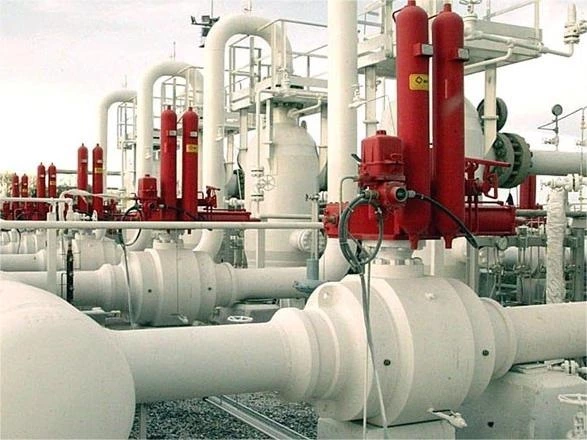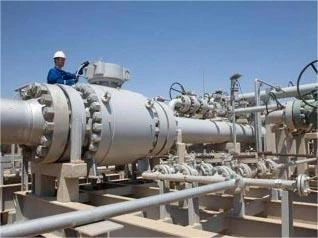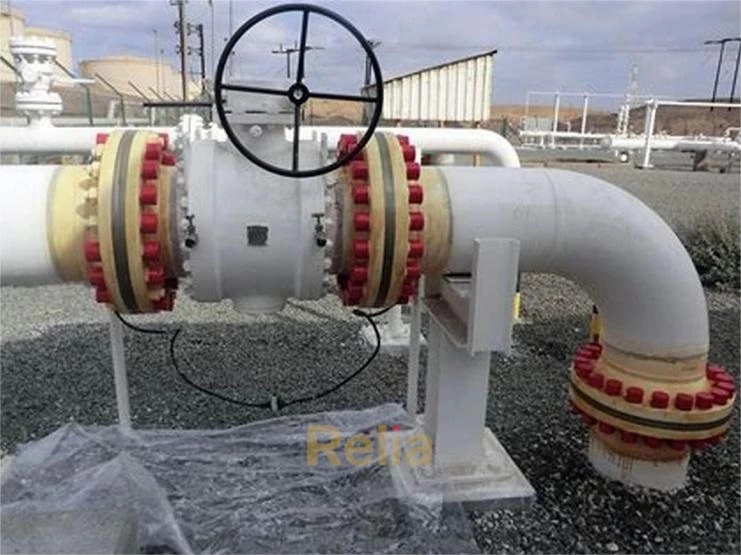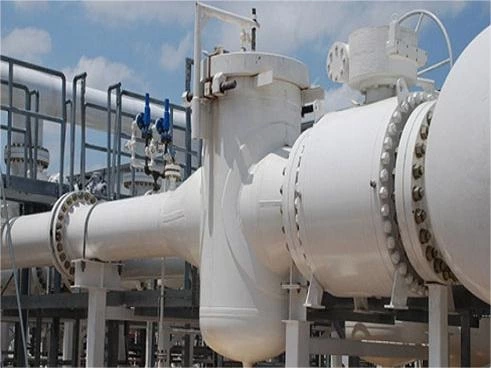Pinch Valves
Pinch valves are flex-body valves consisting of a flexible tube that is pinched either mechanically, as in the valves shown in Figure 3-88 through Figure 3-90, or by the application of fluid pressure to the outside of the valve body, as in the valves shown in Figure 3-91 and Figure 3-92.
One of the principal advantages of this design concept is that the flow passage is straight without crevices and moving parts. The soft valve body also can seal around trapped solids. Pinch valves are, therefore, suitable for handling slurries and solids that would clog in obstructed flow passages and for the sanitary handling of foodstuffs and pharmaceuticals. Depending on the construction material used for the valve body, pinch valves will also handle severely abrasive fluids and most corrosive fluids.
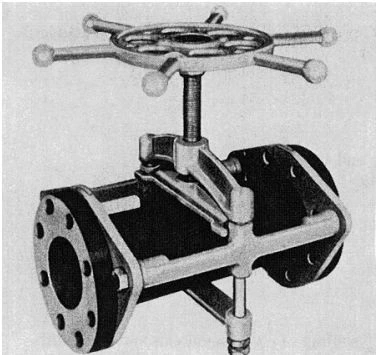
Figure 3-88. Pinch Valve, Open Construction. (Courtesy of Flexible Valve Corporation.)

Figure 3-89. Pinch Valve, Enclosed Construction, and Valve Body 50% Prepinched for Sensitive Flow Control. Drain Plug May Be Removed for Vacuum Connection When Valve Is Used on Vacuum Service. (Courtesy of RKL Controls, Inc.)
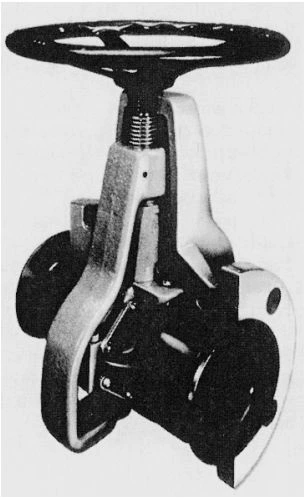
Figure 3-90. Pinch Valve, Enclosed Construction, PTFE Valve Body Fitted with Tear Drops. (Courtesy of Resistoflex Corporation.)
Open and Enclosed Pinch Valves
Mechanically pinched valves may be of the open type, as in the valve shown in Figures 3-88 or of the enclosed type, as in the valves shown in Figures 3-89 and 3-90.
The open construction is used if it is desirable to inspect the valve body visually and physically while the valve is in service. Bulges and soft spots in the valve body are signs that the valve body needs to be replaced.
If the escape of the fluid from an accidentally ruptured valve body cannot be tolerated, the valve body must be encased. The casing is typically split along the axis of the flow passage for convenient access, but casings of unit construction are also being made.
Flow Control with Mechanically Pinched Valves
Pinch valves give little flow control between the fully open and the 50% pinched position because of the negligible pressure drop at these valve positions. Any further closing of the valve gives reasonable flow control. Mechanically pinched valves for flow control duty are often 50% prepinched.
If the fluid is severely erosive, flow control near the closed valve position must be avoided to prevent grooving the valve body. For this reason, pinch valves for erosive duty must be closed permanently and fluid-tight to prevent grooving of the valve body due to leakage flow.
Flow Control with Fluid-Pressure Operated Pinch Valves
Fluid-pressure-operated pinch valves are generally not suitable for manual flow control because any change in the downstream pressure will automatically reset the valve position. The flow control characteristic fluid pressure operated pinch valves, such as the one shown in Figure 3-91, is otherwise similar to that of mechanically pinched valves.

Figure 3-91. Pinch Valve, Fluid-Pressure Operated. (Courtesy of RKL Controls, Inc.)
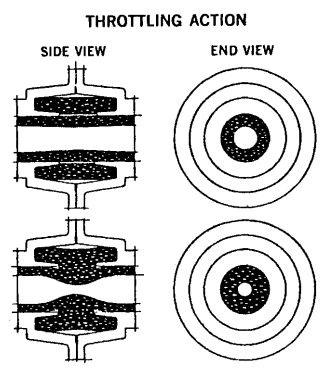
Figure 3-92. Pinch Valve, Fluid-Pressure Operated, with Iris-Like Closing Action. The Constricting Action of the Rubber Muscle upon the Sleeve Is a 360° Squeeze. Pressure is Evenly Applied to the Circumference of the Sleeve—Hence the Always Round, Always Centered Hole. (Courtesy of the Clarkson Company.)
An exception to this flow control characteristic is the valve shown in Figure 3-92, in which the closing action of the valve body is iris-like. This closing action gives equal percentage flow control throughout.
The iris-like closure allows the valve to pass larger particles through in any valve position than is possible with any other valve. This ability considerably reduces the tendency of some slurries to bridge in the partly closed valve. The circular throttling orifice eliminates the grooving of the valve body that develops in other types of pinch valves when severely throttling abrasive fluids. On the debit side, the valve cannot be fully closed.
Valve Body
The valve body is made of an elastomer, PTFE, a similar material, or a combination of these materials. Fabric reinforcement may be used to increase the mechanical strength of the valve body.
Natural rubber is the best construction material for the valve body from the point of resistance to cracking from flexing. Natural rubber also shows excellent resistance to abrasive wear and to corrosion from many corrosive fluids.
If the fluid is chemically active, the surface of highly stressed rubber is more readily attacked than that of unstressed rubber. The corrosives may also form a thin, highly resistant film of corrosion products, which is much less flexible than the parent rubber. This film will crack on severe flexing and expose the rubber to further attack. Repeated flexing will finally lead to cracking right through the rubber.
Some of the synthetic rubbers are considerably less subject to this form of attack than natural rubber. These rubbers extend, therefore, the application of pinch valves for corrosive fluids. In developing such compounds, manufacturers aim not only at corrosion resistance but also at high tensile strength combined with softness for abrasion resistance and ease of closure.
To minimize the severity of flexing, the inside of the valve body may be provided with groove-like recesses on opposite sides, along which the valve body folds on closing. The valve shown in Figure 3-90 reduces the severity of flexing by providing teardrops inside the valve body on opposite sides. This design permits the valve body to be made entirely of PTFE.
Limitations
The flexible body puts some limitations on the use of pinch valves. These limitations may be overcome in some cases by unique body designs or the valve operation method.
For example, fluid-pressure-operated pinch valves tend to collapse on suction duty. The body must be positively attached to the operating mechanism if mechanically pinched valves are used for this duty.
Pinch valves on the downstream side of a pump should always be opened before starting up the pump. If the valve is closed, the air between the pump and the valve will compress and escape rapidly upon cracking the valve. The following liquid column will then hit the valve body with a heavy blow—perhaps severe enough to burst the valve body.
Pinch valves may also fail if the flow pulsates. The valve body will pant and finally fail due to fatigue.
There is a limitation when using pinch valves as the main shut-off valve in liquid-handling systems where the liquid can become locked and has no room to move. Because the valve must be able to displace a certain amount of liquid when closing, the valve cannot be operated in this situation. Any effort to do so may cause the valve body to burst.
Standards On Pinch Valves
National standards that apply specifically to pinch valves do not exist.
Applications
Duty:
- Stopping and starting flow
- Controlling flow
Service:
- Liquids
- Abrasive slurries
- Powders
- Granules
- Sanitary handling of pharmaceuticals and foodstuffs
